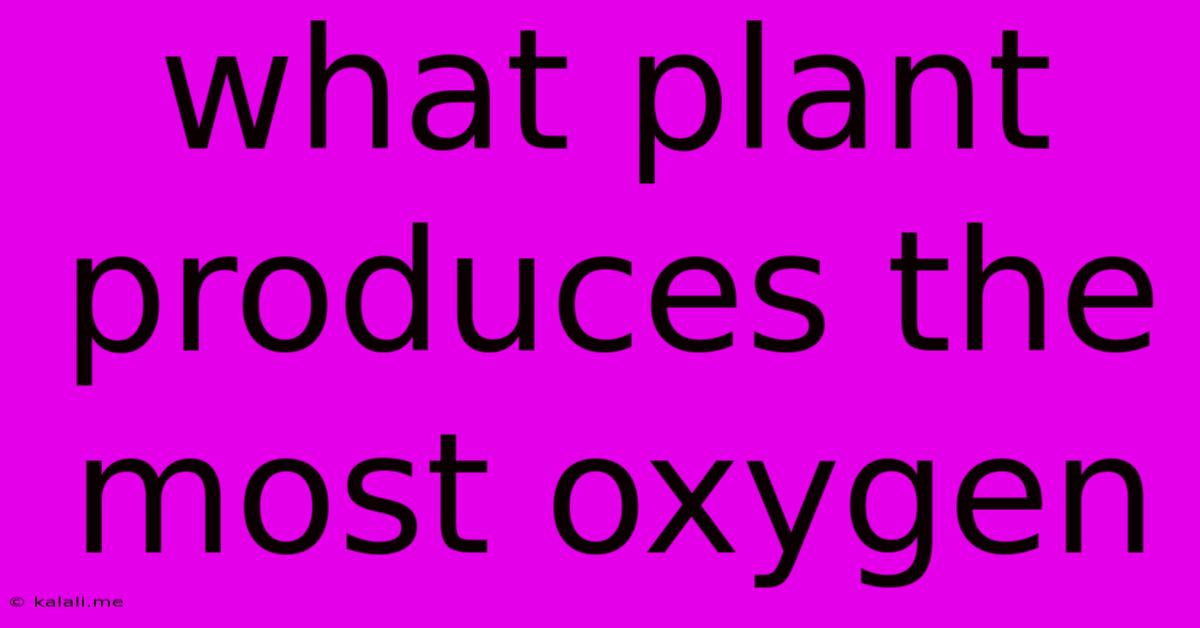What Plant Produces The Most Oxygen
Kalali
Jun 10, 2025 · 3 min read

Table of Contents
What Plant Produces the Most Oxygen? The Surprising Answer
Meta Description: Discover which plant reigns supreme in oxygen production, surprising you with the answer and explaining the complex relationship between plants, oxygen, and the environment. Learn about the factors influencing oxygen production and the importance of diverse ecosystems.
While the Amazon rainforest often gets the limelight as the "lungs of the planet," the title of "most oxygen-producing plant" isn't so easily claimed. It's not about a single champion plant species, but rather a complex interplay of factors including the type of plant, its size, and the overall health of its ecosystem.
The Role of Phytoplankton: Tiny Giants of Oxygen Production
The surprising truth is that phytoplankton, microscopic marine algae, are responsible for a staggering 70-80% of the Earth's oxygen production. These tiny organisms, inhabiting the world's oceans, perform photosynthesis on a massive scale, converting carbon dioxide into oxygen. Their contribution far surpasses that of any terrestrial plant, including the mighty Amazonian trees.
Think about the sheer vastness of the oceans compared to the area covered by forests. While individual trees might produce significant oxygen, the cumulative effect of trillions upon trillions of phytoplankton dwarfs any single terrestrial plant's output.
The Amazon and Other Forests: Significant Oxygen Contributors
This doesn't diminish the importance of forests, however. Terrestrial plants, including the Amazon rainforest, contribute a significant amount of oxygen to the atmosphere. Forests are vital for maintaining biodiversity, regulating the water cycle, and sequestering carbon dioxide – a process that indirectly aids oxygen production. Different types of trees have different oxygen production rates, dependent on factors such as leaf surface area, photosynthetic efficiency, and overall health.
Key factors influencing oxygen production in forests include:
- Species diversity: A diverse forest ecosystem generally supports higher levels of oxygen production.
- Sunlight availability: Optimal sunlight is essential for efficient photosynthesis.
- Water availability: Sufficient water is crucial for plant growth and photosynthesis.
- Nutrient availability: Healthy soil provides essential nutrients for plant growth and development.
- Climate: Temperature and precipitation play a critical role in plant growth and photosynthetic rates.
Beyond Simple Oxygen Production: The Bigger Picture
Focusing solely on which single plant produces the most oxygen oversimplifies a crucial ecological process. The Earth's oxygen levels are a result of a complex balance between photosynthesis (oxygen production) and respiration (oxygen consumption). This balance involves not just plants, but all living organisms.
Moreover, the importance of plants goes far beyond their oxygen production. They are crucial for:
- Carbon sequestration: Plants absorb significant amounts of carbon dioxide from the atmosphere, mitigating climate change.
- Biodiversity support: Plants form the base of many food chains, supporting diverse ecosystems.
- Soil stabilization: Plant roots help prevent soil erosion.
- Water cycle regulation: Plants play a critical role in the water cycle through transpiration.
Therefore, instead of searching for a single "champion" plant, we should focus on protecting and preserving the diverse ecosystems that support both terrestrial and aquatic plant life, ensuring the continued production of oxygen and the health of our planet. The collective effort of all plants, especially the often-overlooked phytoplankton, ensures the air we breathe.
Latest Posts
Latest Posts
-
How Many Coats Of Polyurethane On Wood
Jun 10, 2025
-
Chemical Change In Cooking Tamales In Chemical Change
Jun 10, 2025
-
Why Does God Have To Create Ex Nihilo
Jun 10, 2025
-
Connect Chromecast To New Network Without Remore
Jun 10, 2025
-
Come In Contact With Or Come Into Contact With
Jun 10, 2025
Related Post
Thank you for visiting our website which covers about What Plant Produces The Most Oxygen . We hope the information provided has been useful to you. Feel free to contact us if you have any questions or need further assistance. See you next time and don't miss to bookmark.